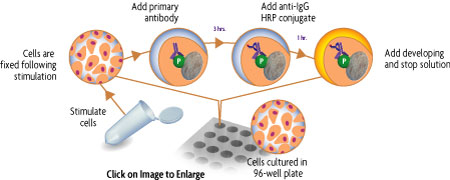THIS PRODUCT IS DISCONTINUED
Fast Activated Cell-based ELISA (FACE™) Kits provide a simple, sensitive method for detecting protein phosphorylation directly in the cell, without making extracts or performing electrophoresis and membrane blotting. These 96-well, high-throughput assays are available in both colorimetric and chemiluminescent formats for over 20 different targets (see list at right). For complete details, click the FACE™ Method tab below.
FACE MEK1/2 Kits provide 96 rxns each of 2 antibodies that enable you to monitor and compare the levels of both phosphorylated and total MEK1/2. The phospho-MEK1/2 antibody recognizes MEK1/2 only when phosphorylated at Ser217/Ser221, and also reacts with MEK1/2 when singly phosphorylated at Ser217 but not at Ser221. The total-MEK1/2 antibody recognizes MEK1/2 proteins regardless of their phosphorylation states. Click the MEK1/2 Info tab below for data and more information.
| Name | Format | Cat No. | Price | |
|---|---|---|---|---|
| FACE™ MEK1/2 | 1 x 96 rxns | 48180 | Discontinued | |
| 5 x 96 rxns | 48680 | Discontinued | ||
| FACE™ MEK1/2 Chemi | 1 x 96 rxns | 48280 | Discontinued | |
| 5 x 96 rxns | 48780 | Discontinued | ||
| FACE™ MEK1/2 Manual |
| FACE™ Profile |
| Cell Biology Products Brochure |
| IsoCyte™ Application Note – Phospho-Protein Detection |
| MSDS: Sodium Azide |
| MSDS: Sulphuric Acid |
| MSDS: Thimersol |

Figure 1: Measurement of phosphorylated and total MEK1/2.
NIH/3T3 cells were cultured in 96-well plates and serum-starved for 16 hours. Cells were then treated with 20% FBS for 30 minutes and fixed. Total and phospho MEK1/2 were each assayed in triplicate using the phospho and total MEK1/2 antibodies included in the FACE MEK1/2 Kit. Data was plotted after correction for cell number (performed through use of Crystal Violet).
Antibody Specificities
The phospho-MEK1/2 antibody is specific for phosphorylated MEK1/2 and was raised against a synthetic phospho-peptide corresponding to residues surrounding Ser217/Ser221 of human MEK1/2. This antibody recognizes MEK1/2 only when phosphorylated at Ser217/Ser221, and also reacts with MEK1/2 when singly phosphorylated at Ser217 but not at Ser221. It does not cross-react with related kinases. The total-MEK1/2 antibody recognizes MEK1/2 proteins regardless of their phosphorylation states.
MEK1/2 Overview
MEK1 and MEK2, also called MAP kinase kinase and ERK activator kinase, are dual-specificity protein kinases that function in a Mitogen Activated Protein Kinase (MAPK) cascade controlling both cell growth and differentiation. MEK1/2 is activated by a wide variety of growth factors and cytokines, and also by membrane depolarization and calcium influx, with the predominant activators being Raf kinases. MEK is involved in the MAPK signaling pathway of Ras-Raf-MEK-ERK. This signaling cascade is an important target in cancer therapy, making high-throughput study methods in demand.
The FACE™ Method
In FACE, cells are cultured in 96-well plates and stimulated to induce the pathway of interest. Following stimulation, the cells are fixed rapidly, which preserves activation-specific protein modifications. Each well is then incubated with a primary antibody specific for the activated protein of interest. Subsequent incubation with secondary HRP-conjugated antibody and developing solution provides a colorimetric or chemiluminescent readout that is quantitative and reproducible (Figure 1). The number of cells in each well can be normalized easily with the provided Crystal Violet solution. FACE Kits also contain primary antibody specific for the native inactive protein, so you can monitor both native and activated protein levels in the same experiment. FACE eliminates cellular extractions, radioactive kinase assays, time-consuming Westerns and inefficient epitope interactions that occur on membranes. FACE is a highly sensitive high-throughput assay designed for detecting activated proteins within mammalian cells.
Figure 1: Flow chart of the FACE process.
Flow chart of the FACE in cell Western method that uses a cell based ELISA to measure the levels of the native and phospho forms of signaling proteins and kinases that are activated by phosphorylation.
Contents & Storage
Two (or ten) 96-well plates for culturing cells, 96 (or 5 x 96) rxns each of two primary antibodies (1 phospho-specific, 1 specific for native protein), HRP-conjugated secondary antibody, Quenching Solution, 1X Antibody Blocking Buffer, 1X Antibody Dilution Buffer, 10X PBS, 10% Triton X-100, 1% SDS Solution, Developing and Stop Solutions, and Crystal Violet Cell Quantification Solution. Storage conditions vary from room temperature to -20°C, see manual for details. All reagents are guaranteed stable for 6 months when stored properly.


